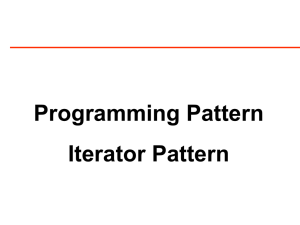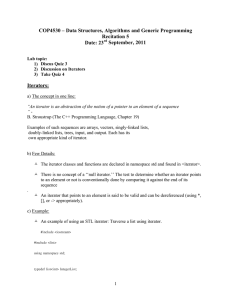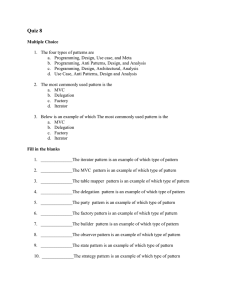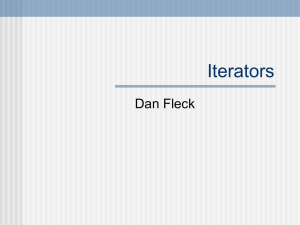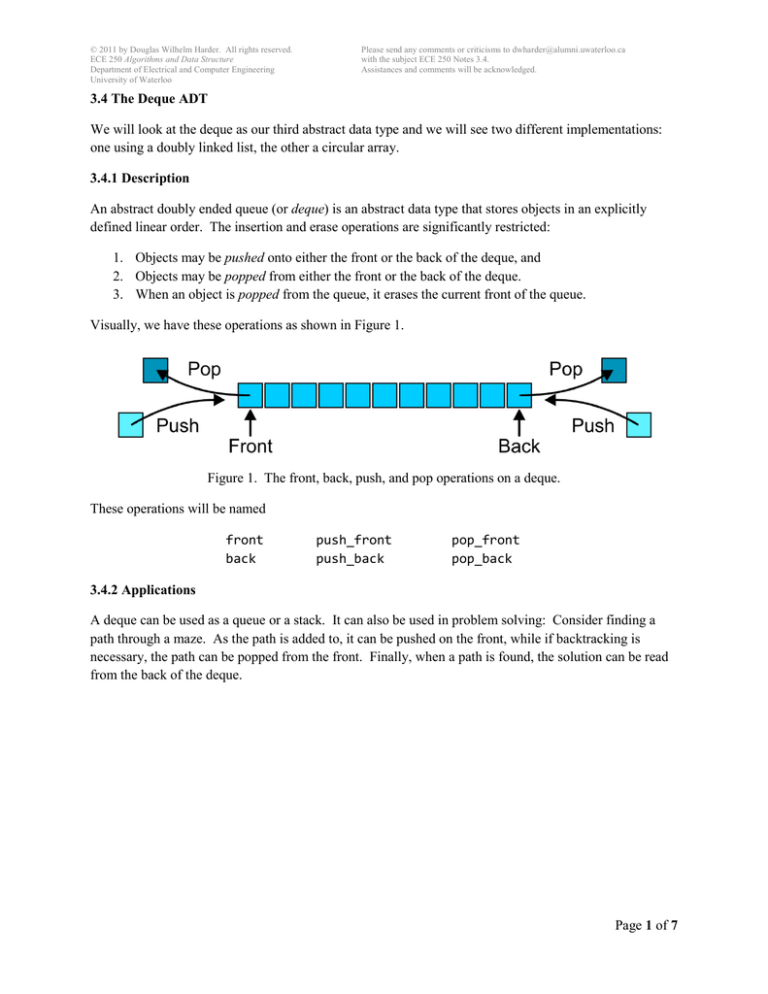
© 2011 by Douglas Wilhelm Harder. All rights reserved.
ECE 250 Algorithms and Data Structure
Department of Electrical and Computer Engineering
University of Waterloo
Please send any comments or criticisms to dwharder@alumni.uwaterloo.ca
with the subject ECE 250 Notes 3.4.
Assistances and comments will be acknowledged.
3.4 The Deque ADT
We will look at the deque as our third abstract data type and we will see two different implementations:
one using a doubly linked list, the other a circular array.
3.4.1 Description
An abstract doubly ended queue (or deque) is an abstract data type that stores objects in an explicitly
defined linear order. The insertion and erase operations are significantly restricted:
1. Objects may be pushed onto either the front or the back of the deque, and
2. Objects may be popped from either the front or the back of the deque.
3. When an object is popped from the queue, it erases the current front of the queue.
Visually, we have these operations as shown in Figure 1.
Figure 1. The front, back, push, and pop operations on a deque.
These operations will be named
front
back
push_front
push_back
pop_front
pop_back
3.4.2 Applications
A deque can be used as a queue or a stack. It can also be used in problem solving: Consider finding a
path through a maze. As the path is added to, it can be pushed on the front, while if backtracking is
necessary, the path can be popped from the front. Finally, when a path is found, the solution can be read
from the back of the deque.
Page 1 of 7
© 2011 by Douglas Wilhelm Harder. All rights reserved.
ECE 250 Algorithms and Data Structure
Department of Electrical and Computer Engineering
University of Waterloo
Please send any comments or criticisms to dwharder@alumni.uwaterloo.ca
with the subject ECE 250 Notes 3.4.
Assistances and comments will be acknowledged.
3.4.3 Implementation
Like the stack and queue, we will require that all the operations of a deque implementation are Θ(1).
3.4.3.1 Doubly Linked List Implementation
Only a doubly linked list allows both insertions and erases at both the front and back in Θ(1) time. We
will therefore use a doubly linked list instead of a singly linked list.
template <typename Type>
class Deque {
private:
Double_list<Type> list;
};
public:
bool
Type
Type
void
void
Type
Type
empty() const;
front() const;
back() const;
push_front( const Type & );
push_back( const Type & );
pop_front();
pop_back();
The implementation is reasonably straight-forward: like our implementations of stacks and queues using
the Single_list class, each of the member functions will call the corresponding member functions in
the Double_list class—as before, this will be a wrapper class.
3.4.3.2 Circular Array Implementation
The implementation of a deque using a circular queue is reasonably straight-forward. It is left as an
exercise to the you to determine the details.
Page 2 of 7
© 2011 by Douglas Wilhelm Harder. All rights reserved.
ECE 250 Algorithms and Data Structure
Department of Electrical and Computer Engineering
University of Waterloo
Please send any comments or criticisms to dwharder@alumni.uwaterloo.ca
with the subject ECE 250 Notes 3.4.
Assistances and comments will be acknowledged.
3.4.4 Deques in the STL
The deque class in the STL has the following definition:
template <typename T>
class deque {
public:
deque();
// not quite true...
bool empty() const;
int size() const;
const T & front() const;
const T & back() const;
void push_front( const T & );
void push_back( const T & );
void pop_front();
void pop_back();
};
An example of this deque in use is given here:
#include <iostream>
#include <deque>
int main() {
deque<int> ideque;
ideque.push_front( 5 );
ideque.push_back( 4 );
ideque.push_front( 3 );
ideque.push_back( 6 );
// 3 5 4 6
std::cout << "Is the deque empty?
std::cout << "Size of deque:
" << ideque.empty() << std::endl;
"
<< ideque.size()
<< std::endl;
for ( int i = 0; i < 4; ++i ) {
std::cout << "Back of the deque:
" << ideque.back() << std::endl;
ideque.pop_back();
}
std::cout << "Is the deque empty?
" << ideque.empty() << std::endl;
return 0;
}
Given a deque with n entries, there are two methods to access an arbitrary entry from 0 ≤ k < n:
ideque[k] and ideque.at( k )
Page 3 of 7
© 2011 by Douglas Wilhelm Harder. All rights reserved.
ECE 250 Algorithms and Data Structure
Department of Electrical and Computer Engineering
University of Waterloo
Please send any comments or criticisms to dwharder@alumni.uwaterloo.ca
with the subject ECE 250 Notes 3.4.
Assistances and comments will be acknowledged.
The only difference between the two is that the second does range checking. If k < 0 or k ≥ n, the member
function at will throw an out_of_range exception. Consequently, using indexing is faster, but less
safe.
The third mechanism for walking through the entries of the deque is to use an iterator. To motivate this,
consider the design of Project 1:
Single_list<int> list;
for ( int i = 0; i < 10; ++i ) { list.push_front( i ); }
for ( Single_node<int> *ptr = list.head(); ptr != 0; ptr = ptr->next() ) {
cout << ptr->retrieve();
}
What happens if the user were to, for example, execute:
delete list.head();
Now, the internal structure of the linked list is no longer consistent: the memory for the first node is no
longer allocated. Thus, the internal state of the linked list is no longer valid. One of the goals of objectoriented programming is to avoid such situations. Therefore, we need a different mechanism for stepping
through a linked list.
3.4.5 Iterators
Within the deque class is a nested class with the declaration:
template< typename T >
class deque<T>::iterator;
Given the instance ideque from above, we may now declare
deque<int>::iterator itr = ideque.begin();
This is equivalent to the Project 1 call:
Single_node<int> *ptr = list.head();
The operations to move forward and backward, however, are much more elegant:
Project 1
ptr->retrieve();
ptr = ptr->next();
ptr = ptr->previous();
Iterators
*itr;
++itr;
--itr;
while operators appear to be the same as for pointers, they are actually overloaded operators.
Numerous member functions of the deque class will return an iterator:
Page 4 of 7
© 2011 by Douglas Wilhelm Harder. All rights reserved.
ECE 250 Algorithms and Data Structure
Department of Electrical and Computer Engineering
University of Waterloo
Member Function
deque<T>::iterator begin();
deque<T>::iterator end();
deque<T>::iterator rbegin();
deque<T>::iterator rend();
Please send any comments or criticisms to dwharder@alumni.uwaterloo.ca
with the subject ECE 250 Notes 3.4.
Assistances and comments will be acknowledged.
Returns an iterators that points to…
the entry at the front of the deque.
a notional position one past the entry at the
back of the deque.
the entry at the back of the deque.
a notional position one prior to the entry at
the front of the deque.
Now, one might wonder why end and rend point to notional positions either past the back or prior to the
front of the deque, respectively. This is so that the standard for loops still work as expected:
for ( deque<int>::iterator itr = ideque.begin();
itr != ideque.end();
++itr ) { // ...
for ( deque<int>::iterator itr = ideque.rbegin(); itr != ideque.rend(); --itr ) { // ...
The first will iterate from the first entry to the last, while the second will iterate from the last entry back to
the first. As well as accessing, it is also possible (as with pointers) to assign to entries already in the
deque:
deque<int> ideque;
ideque.push_front(3);
deque<int>::iterator itr = ideque.begin();
*itr = 8;
std::cout << *itr << std::endl;
// This would print out 8
While this is valid, it is invalid to add to a deque by assigning to the end iterator:
// Invalid method
// *ideque.end() = 4;
// Correct method
ideque.push_back( 4 );
Why use iterators? For numerous reasons:
1. They hide the implementation—the underlying data structure could be an array, a linked list, or
something more complex; however, this can be changed and so long as the code for the iterator is
adjusted, the behaviour of the iterator will not change,
2. All operations on an iterator are performed in Θ(1) time, and
3. It provides a common interface across all containers within the STL.
Page 5 of 7
© 2011 by Douglas Wilhelm Harder. All rights reserved.
ECE 250 Algorithms and Data Structure
Department of Electrical and Computer Engineering
University of Waterloo
Please send any comments or criticisms to dwharder@alumni.uwaterloo.ca
with the subject ECE 250 Notes 3.4.
Assistances and comments will be acknowledged.
3.4.6 Iterators for the Single_list Class (Optional)
The following provides for a forward traversing iterator for the Single_list class.
3.4.6.1 Changes to the Single_list Class Definition
The member functions head and tail would be made private:
private:
Single_node<Type> *head() const;
Single_node<Type> *tail() const;
The iterator class would be public and we would introduce three new member functions: begin, end and
find.
public:
class iterator {
private:
iterator( Single_node<Type> * );
Single_node<Type> *current;
public:
Type &operator*();
iterator operator++();
iterator operator++( int );
bool operator==( iterator const & ) const;
bool operator!=( iterator const & ) const;
};
friend class Single_list;
iterator begin() const;
iterator end() const;
iterator find( Type const & ) const;
The implementation of the three member functions is straight-forward:
template <typename Type>
typename Single_list<Type>::iterator Single_list<Type>::begin() const {
return iterator( head() );
}
template <typename Type>
typename Single_list<Type>::iterator Single_list<Type>::end() const {
return iterator( 0 );
}
template <typename Type>
typename Single_list<Type>::iterator Single_list<Type>::find( const Type &obj ) const {
for ( Single_node<Type> *ptr = list_head; ptr != 0; ptr = ptr->next() ) {
if ( ptr->retrieve() == obj ) {
return iterator( ptr );
}
}
}
return iterator( 0 );
Page 6 of 7
© 2011 by Douglas Wilhelm Harder. All rights reserved.
ECE 250 Algorithms and Data Structure
Department of Electrical and Computer Engineering
University of Waterloo
Please send any comments or criticisms to dwharder@alumni.uwaterloo.ca
with the subject ECE 250 Notes 3.4.
Assistances and comments will be acknowledged.
The implementation member functions of the iterator class simply update or access the Single_node
member variable.
// Create a new iterator pointing to the Single_node passed as an argument
template <typename Type>
Single_list<Type>::iterator::iterator( Single_node<Type> *ptr ):
current( ptr ) {
// empty constructor
}
// Return the element stored in the current node
// It is returned by reference and can therefore be changed
template <typename Type>
Type &Single_list<Type>::iterator::operator*() {
return current->element;
}
// If we are not already at the end, push the pointer forward one in the linked list
// Return an iterator also pointing to the current object
template <typename Type>
typename Single_list<Type>::iterator Single_list<Type>::iterator::operator++() {
if ( current != 0 ) {
current = current->next();
}
}
return iterator( current );
// If we are not already at the end, push the pointer forward one in the linked list
// Return an iterator pointing to the original node in the linked list
template <typename Type>
typename Single_list<Type>::iterator Single_list<Type>::iterator::operator++( int ) {
Single_node<Type> *previous = current;
if ( current != 0 ) {
current = current->next();
}
}
return iterator( previous );
// Check if two iterators are equal by comparing the values of the pointers
template <typename Type>
bool Single_list<Type>::iterator::operator==( Single_list<Type>::iterator const &itr ) const {
return current == itr.current;
}
// Check if two iterators are different by comparing the values of the pointers
template <typename Type>
bool Single_list<Type>::iterator::operator!=( Single_list<Type>::iterator const &itr ) const {
return current != itr.current;
}
Page 7 of 7

